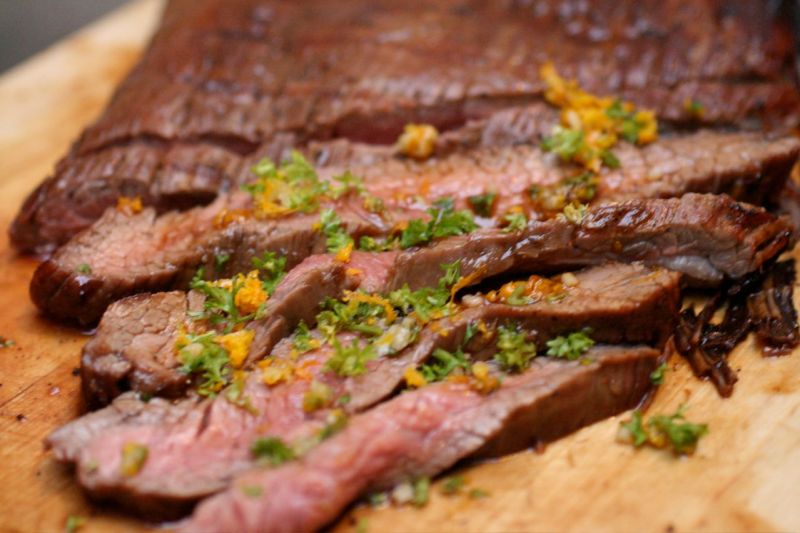It’s so common to adhere to a healthy diet plan and wonder about the food that should be permitted and those that should be excluded. As you’ve been excelling with healthy eating, you can’t help but think about how to keep your diet healthy and creative. One commonly overlooked source of flavor and protein is the flank steak.
It’s hard to be at the top of the list with so many lovers of the ribeye, sirloin, and T-bone steak, but the flank steak is a humble cut that can be incorporated nicely into your meal plans and can have a beneficial impact on your health and wellness. As we explore flank steak nutrition components and how to prepare this cut, you’ll be able to see the meal-prepping horizons broaden right before your eyes.
Is flank steak healthy?

You may be surprised, but flank steak can help boost your wellness. This lean beef is a good source of iron and zinc, which supports recovery after working out. Additionally, it contains fewer calories compared to its fatty counterparts, like a ribeye steak.
A lean cut like the flank steak can be a great choice if you want to stick with low-calorie choices and keep your weight down. It’s also advantageous for physical fitness because lean protein is vital for muscle building, but it’s often under-consumed compared to fatty meats.
Nutritional facts of flank steak

Flank steak is a nutritious and healthy cut of lean beef that will help you with weight management and boost overall wellness. This is a low-calorie cut that serves as a good source of protein and isn’t loaded with carbs or sugars. Additionally, flank steak will provide a decent amount of minerals like iron, zinc, and magnesium, as well as calcium and phosphorus. It also contains B vitamins like niacin, B6, B12, and folate. These minerals and vitamins are vital to your bone health, energy levels, and blood pressure regulation, among many other critical metabolic processes.
The nutritional composition of flank steak resembles the nutritive profile of lean beef cuts, consisting of selenium, vitamin K, and B vitamins like pantothenic acid and thiamin. Though these are lean cuts, there are some fatty acid components beneficial for the heart, like linoleic acid, oleic acid, and stearic acid. Consuming healthy fats can help decrease the low-density lipoprotein content or increase high-density lipoproteins, which can combat the risk factors for stroke and heart complications.
Red meat often gets a bad reputation, but the vitamins and minerals found in these cuts are crucial for sustaining and benefitting your health status. Selenium is necessary for defending your system against oxidative damage, while vitamin K supports proper blood clotting and bone structure along with phosphorus and calcium. You don’t want to cut red meats out completely because restriction of these meat sources is often associated with iron insufficiency and lack of vitamins that may not be as abundant in plant sources.
How to incorporate flank steak into your diet

Don’t be afraid to include flank steak in your diet. This underappreciated cut of beef is finally getting its due shine, and there are plenty of exciting ways to enjoy this cut. Quickly cooking your flank steak on high heat will make it a flavorful and tender part of your meal. You can serve it as the main course with some greens and potatoes or blend it into a stir-fry. Another savory treat would be to stuff fajitas or tacos with shredded flank steak.
Tips for making flank steak healthier
Selecting the best seasonings and marinades to prepare your steak can be a great way to make your flank steak healthier. Start with using Kosher salt instead of table salt because Kosher salt doesn’t contain the chemical additives that table salt possesses. You should also explore the many spices available because the spices and herbs in your pantry can serve as your medicine cabinet! So many natural goodies like ginger, rosemary, thyme, and onion have health-boosting properties.
Alternate choices for flank steak

One alternate cut choice is the skirt steak. This cut is similar in composition to the flank steak. The skirt steak, like the flank steak, is very lean and flavorful when cooked correctly. The skirt steak is half an inch thick, while the flank is three-fourths to one inch thick. Both cuts require simple preparation to bolster the flavor and tenderness. Just cooking it on high heat for a quick cooking time with a tasty marinade and herbs should be sufficient.
Frequently asked questions

Is flank steak the healthiest steak?
Flank steak may not be the healthiest for sure, but it is among one of the healthiest steak cuts. Many lean steaks are in the running for the healthiest steak, like top sirloin, eye of round, and sirloin tip side steak. These cuts get a bad rep for texture and taste, but they can be tender and flavorful with the right preparation. More noteworthy are the immune-boosting components they contain, like zinc and iron. These underrated cuts are also stuffed with B vitamins like riboflavin, niacin, B6, and B12, which support cell growth and energy.
How many calories are in four ounces of cooked flank steak?
There are roughly 165 calories in flank steak. The average 3.5 to four-ounce serving of a lean steak cut may contain between 140 and 276 calories.
Is flank steak lean or fatty?
The flank steak is lean, and it’s the only cut that comes from the cow’s abs. It is a long and thin cut that only requires grilling or cooking each side on high heat for a few minutes. You can braise or broil your flank steak for a few moments, and you can also let it soak in a marinade overnight for added flavor.



